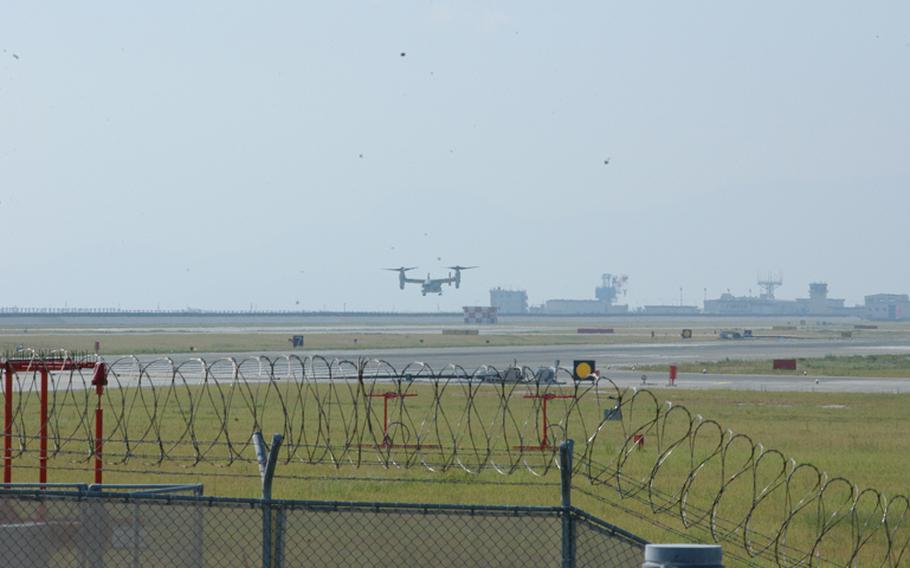Asia-Pacific
Controversial Ospreys start test flights over Japan
Stars and Stripes September 21, 2012

The first MV-22 Osprey to leave the ground in Japan takes off from the flight line at Marine Corps Air Station Iwakuni on Sept. 21, 2012. (Matthew M. Burke/Stars and Stripes)
MARINE CORPS AIR STATION IWAKUNI, Japan - The controversial MV-22 Ospreys hovered and cut through sunny skies above Japan for the first time Friday as protesters, media and curious passersby watched the airplane-helicopter hybrids.
Japan announced Wednesday it had confirmed the Osprey's safety and gave the green light for test flights to begin at Marine Corps Air Station Iwakuni before the first squadron is deployed to Marine Corps Air Station Futenma on Okinawa in the next few weeks to replace a fleet of aging CH-46E Sea Knights.
The Ospreys had been sitting idle since arriving in July as the Japanese studied the MV-22's safety record. Two crashes earlier this year raised concerns among residents still cautious after a 2004 crash of a Sea Stallion helicopter on the campus of Okinawa International University, which sits adjacent to Futenma.
Marine Corps officials reiterated Friday that the aircraft is one of the safest in the U.S. military's arsenal.
"Basing the MV-22 Osprey in Okinawa will significantly strengthen the United States' ability to assist in the defense of Japan, perform humanitarian assistance and disaster relief operations, and fulfill other alliance roles," III Marine Expeditionary Force spokesman 1st Lt. Greg Carroll wrote in a statement.
"Our most valuable relationships," he continued, "are with our community neighbors - we consistently do our utmost to keep our community safe, and will continue to do so as MV-22 Ospreys arrive in Okinawa."
While government officials in Tokyo lauded the Osprey, local authorities remained skeptical. Yamaguchi Gov. Shigetaro Yamamoto announced he had declined a Marine Corps offer of a ride.
"It is of my great disappointment that the test flights started while concerns about the aircraft's safety remain strong among the public," he said in a statement.
Marine Corps officials said there would be no media opportunities while the Ospreys are in Iwakuni due to operational tempo so the media were forced to monitor the test flights from a seawall outside the runway fence.
The flights Friday began in the morning and continued into the afternoon. An Osprey would taxi to the runway, lift and hover for several seconds, then take off as a helicopter out to sea. Less than an hour later, it was back, landing as a helicopter. It was unclear if the aircraft switched to and from airplane mode while over water.
About 100 protesters and an equal amount of Japanese media watched. An estimated 25,000 people turned out for a recent protest on Okinawa.
Naoko Kadota, 29, came from nearby Hiroshima to show solidarity with the Japanese anti-Osprey movement.
"Our biggest fear is about the safety," Kadota said. "Although the government said the spate of accidents was all due to human errors, it gives us the impression that the Osprey is hard to operate."
Protesters carried signs and chanted, "Don't fly Osprey. No Osprey in Iwakuni. No Osprey in Okinawa."
Not everyone was there to protest. Some traveled from near and far just to see what the fuss was about. Nobuyuki Kurimoto, 67, from Iwakuni, stopped by and strolled the seawall for a chance to see the Osprey.
"The noise is not as bad as I had thought," Kurimoto said. "It's like a regular helicopter."He said he wasn't worried about the aircraft's safety here because the runway extends to the sea.
"We know the aircraft will fly over the water," he said.
The MV-22 Ospreys, part of Marine Medium Tiltrotor Squadron 265, will be conducting aircraft functional check flights and pilot proficiency flights in Iwakuni over the next several weeks, Carroll said in the statement. The flights will take place mostly over water or MCAS Iwakuni air space.